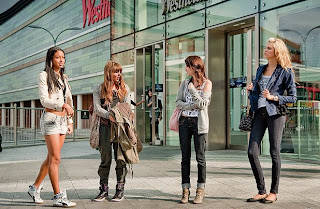I used Facebook and Google Documents to help me conduct my audience research. It was very easy to get many people to complete my audience research, making it easier for me to see how i could appeal to my target audience. I also went through a similar process when evaluating the audience response.
I sent out a message to my friends on Facebook, which had a link to the Google Document i had created:
 Once everyone had completed my audience research, the results were put into a spread sheet, making it eay for me to identify any trends within my research.
Once everyone had completed my audience research, the results were put into a spread sheet, making it eay for me to identify any trends within my research.YouTube was also useful, as i used it for my product research. YouTube has many official teaser trailers, so i had a many teen drama trailers that i could look at. This helped me understand the conventions of teen drama. However, anyone can upload a trailer to YouTube, meaning that i had to be careful that the trailers i studied were not fan made.
As for planning, Google Calender was very useful for making sure i made the best use of my time and was aware of the deadline.

During the construction, i relied entirely upon Imovie HD and Photoshop CS3. Without Imovie, it would have been difficult to achieve fast-paced editing that is conventional within teaser trailers. Without Imovie, my magazine and film poster would have looked amateur.
Such programmes have made it possible for anyone to become a producer of media. In the past, it would have only been the privileged who were able to produce films, now it is open to almost anyone.
I also used free font sites such as CoolText to construct my magazine and film poster. This meant that i had more choice when it came to choosing my typography.
The issue of copyright was something i also had to overcome when it came music. As i could not get permission to use songs by well-known artists, i used this site. On this site you can use music by unsigned bands, which means there are no copyright issues.

In the planning, research and evaluation, I used blogger to record the findings of my research and to communicate my ideas in a way that is easily accessible to the reader.
Blogger also made it easy to reflect upon my progress throughout the course, making my evaluation more accurate, and also meaning that details i may have forgotten were recorded on my blog.
 From my audience feedback, i can see that my film poster was effective for the majority of my audience. When the people that replied 'no' to the above question were asked to explain their answer, i was told that the film poster did not give away enough of the narrative. So in retrospect, perhaps more images or text on the film poster would have been a good way to make it have a wider appeal.
From my audience feedback, i can see that my film poster was effective for the majority of my audience. When the people that replied 'no' to the above question were asked to explain their answer, i was told that the film poster did not give away enough of the narrative. So in retrospect, perhaps more images or text on the film poster would have been a good way to make it have a wider appeal. 



















